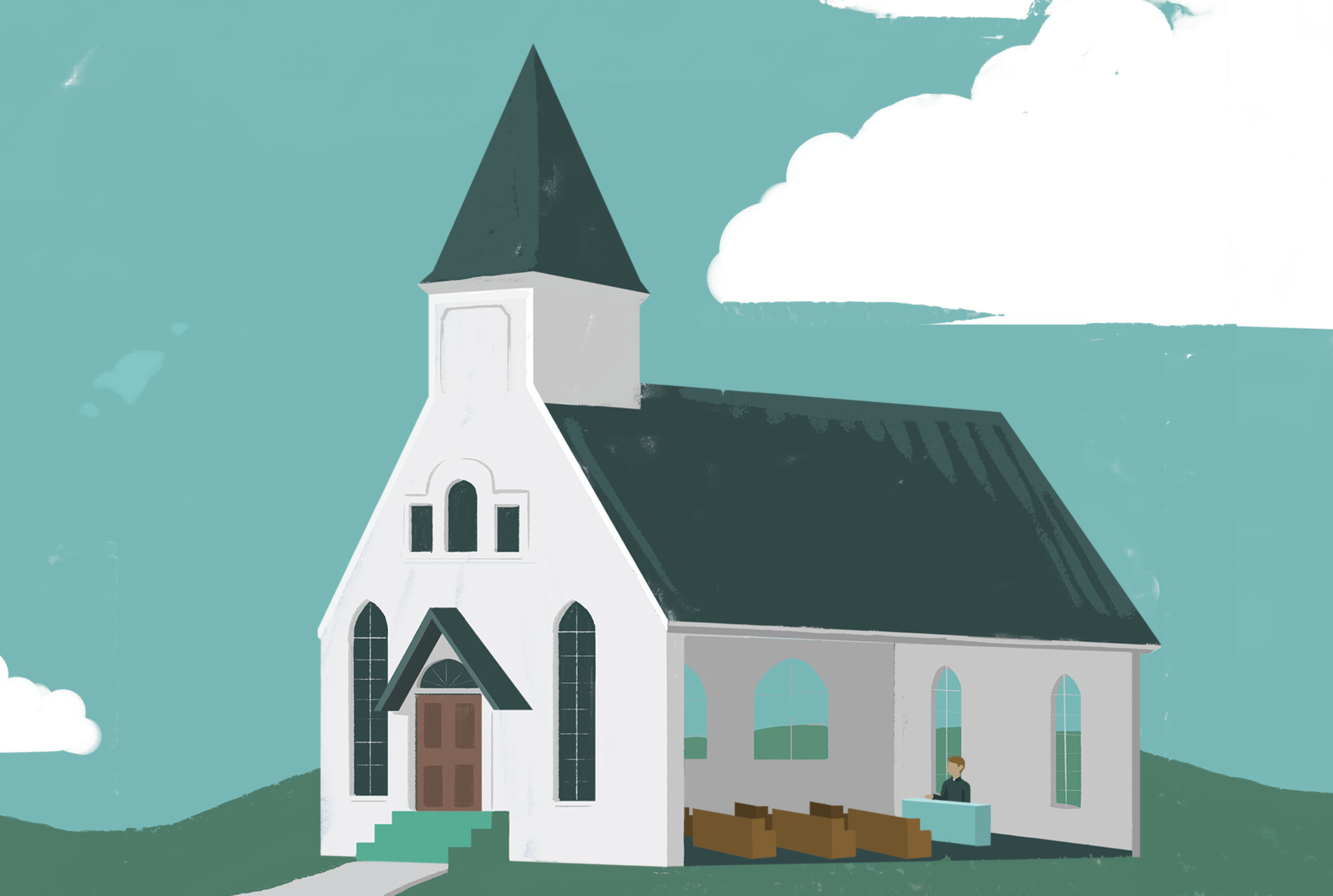March 24, 2022
Generation Z and the Future of Faith in America

Acknowledgments
The Survey Center on American Life of the American Enterprise Institute is grateful to the John S. and James L. Knight Foundation for its generous support of the American National Family Life Survey.
In addition, the author would like to thank Beatrice Lee, Dana Popky, and Grace Burns for their research assistance and support with the design of the report figures; Sarah Burns and Josh Delk for their strategic insights and communications support; Abigail Guidera for her detailed oversight and administrative assistance; Sarah Bowe for her careful and efficient editing; and Danielle Curran for her design and aesthetic expertise.
The story of religious change in America, especially religious disaffiliation, is often cast as the result of independent decisions made by a rising generation living by a different set of values.[1] But new evidence paints a much more complicated picture than the traditional narrative of generationally driven disaffiliation. Young adults today have had entirely different religious and social experiences than previous generations did. The parents of millennials and Generation Z did less to encourage regular participation in formal worship services and model religious behaviors in their children than had previous generations. Many childhood religious activities that were once common, such as saying grace, have become more of the exception than the norm.
We have long known the importance of formative religious experiences in setting the trajectory of faith commitments throughout life. For as long as we have been able to measure religious commitments, childhood religious experiences have strongly predicted adult religiosity.[2] They still do. If someone had robust religious experiences growing up, they are likely to maintain those beliefs and practices into adulthood.[3] Without robust religious experiences to draw on, Americans feel less connected to the traditions and beliefs of their parents’ faith.
There is little evidence to suggest that Americans who have disaffiliated will ever return. First, the age at which Americans choose to give up their families’ religion—most well before they turn 18—suggests that they have not established a deeply rooted commitment to a set of religious beliefs and practices. Disaffiliated Americans express significant skepticism about the societal benefits of religion, even more than those who have never identified with a religious tradition. They also strongly disagree with the majority of religious Americans, who believe in the importance of raising children in a religious faith. Moreover, having children does not appear to affect religious involvement. Unaffiliated parents are not any more likely to be religiously active than those without children, and most are unconvinced that religion serves as an important source of moral instruction.
Religious participation has typically been tightly connected to the timeline of important life events, such as getting married and having children.[4] These events and experiences can serve as crucial opportunities for those who have left their childhood faith to reconnect to a religious community. But declining confidence in organized religion and a growing trend of secular relationships and marriages may make these seminal moments less likely to encourage Americans to return.[5]
These changes have considerable personal and societal consequences. Individually, Americans who report leaving their formative religion report more significant personal hardship than those who were raised—and remain—religious. This is particularly true for Americans who disaffiliate from more conservative religious traditions; 39 percent of Americans raised evangelical Protestant but who no longer identify with the religion say they feel lonely or isolated from the people around them most or all the time. In contrast, only 23 percent of former Catholics say the same.
The decline of religion has implications for American civic and social life as well. Religious Americans are generally more socially and civically active. However, the frequency of religious participation—not one’s religious identity—appears to be the most important factor in determining the level of engagement in other social and civic activities. Americans who regularly attend services are far more engaged in community life than are those who seldom or never attend religious services.
And although higher education has been shown to be strongly associated with an increased propensity toward joining social groups and civic associations, religion still appears to play a significant function.[6] There is evidence that education level and religious involvement both augment participation in community life. College-educated Americans who are religious tend to exhibit the highest levels of civic engagement.
The Generation Gap in Religious Affiliation
American religious identity has experienced nearly three decades of consistent decline. But this roughly linear trend masks significant generational variation in religious identity. Research has consistently shown that every generation of adults is somewhat less religious than the generation that preceded it.[7] This pattern continues with Generation Z demonstrating less attachment to religion than the millennial generation did.[8]
In terms of identity, Generation Z is the least religious generation yet. More than one-third (34 percent) of Generation Z are religiously unaffiliated, a significantly larger proportion than among millennials (29 percent) and Generation X (25 percent). Fewer than one in five (18 percent) baby boomers and only 9 percent of the silent generation are religiously unaffiliated.
It’s not only a lack of religious affiliation that distinguishes Generation Z. They are also far more likely to identify as atheist or agnostic. Eighteen percent of Gen Z affirmatively identify as either atheist (9 percent) or agnostic (9 percent). In contrast, fewer than one in 10 (9 percent) baby boomers and 4 percent of the silent generation identifies as atheist or agnostic.
A Generational Divide in Formative Religious Experiences
Involvement in formal religious activities—those organized through a church or place of worship—is much less common for young people today than it was a generation ago. A majority (57 percent) of baby boomers report having attended religious services with their families at least once a week during their childhoods. Millennials and Gen Zers are much less likely to report attending worship services growing up. Less than half of millennials (45 percent) and Gen Zers (40 percent) say they attended church weekly.
Participation in religious education activities or Sunday school also reveals a substantial generational divide. Sixty-one percent of baby boomers report having attended Sunday school or some other type of religious education program during their childhoods, compared to roughly four in 10 millennials (43 percent) and Gen Zers (42 percent).
With more-informal religious activities, especially those taking place at home, the differences among generations are more modest. Roughly one in five baby boomers (17 percent) say they read religious stories or scripture with their families at least once a week growing up. Millennials (24 percent) and Gen Zers (21 percent) are slightly more likely to have engaged in this activity. Baby boomers are somewhat more likely than younger generations are to say they prayed with their families or said grace at meals; 48 percent report having done this at least once a week during their childhoods. About four in 10 millennials (42 percent) and Gen Zers (40 percent) report praying or saying grace with their families at meals at least once a week.[9]
The modest generational division in saying grace or praying at meals is noteworthy given how much less often younger generations report eating meals with their families as children. Seventy-six percent of baby boomers say they had “meals together as a family” every day when they were growing up, an experience shared by less than half (46 percent) of millennials and only 38 percent of Generation Z.
The Catholic Participation Gap
The generation gap in formal religious activities is especially pronounced among those raised in Catholic households. Among baby boomers who were raised Catholic, 71 percent say they attended church at least once a week with their families. Only about half (51 percent) of millennials raised in Catholic households report attending weekly church services as a family.
Attending Sunday school was also a fairly typical experience for Catholic baby boomers, but far less so for their children’s generation. About seven in 10 (71 percent) baby boomers brought up in Catholic households report attending Sunday school or a religious education program at least weekly while growing up. Less than half (44 percent) of millennials raised Catholic report attending Sunday school as a child.
The Uniquely Religious Upbringing of Black Americans
Black Americans are unique in their formative religious experiences. But the racial gaps are largest among activities that take place at home. Nearly seven in 10 (69 percent) Black Americans report they said grace or prayed with their families during mealtimes at least once a week growing up, an activity far less common among other racial groups. Less than half of White (42 percent), Hispanic (41 percent), and Asian Americans (31 percent) report praying or saying grace with their families during mealtimes at least weekly.
Across racial and ethnic groups, women exhibit higher levels of religious engagement than do men. However, despite similar childhood experiences, the gender gap in religious engagement among Black Americans is significantly higher than that of any other racial or ethnic group. About half (51 percent) of Black women report being a member of a church or religious organization, compared to only about one in three (35 percent) Black men. Black women are also nearly twice as likely as Black men are to be a member of a prayer or Bible study group (32 percent vs. 17 percent, respectively).
Family Structure and Religious Upbringing
Trends in religious affiliation are likely being affected by the substantial shift in American family structure. A recent Pew Research Center study found that nearly one in four (23 percent) Americans are raised in single-parent households, a higher rate than any other country in the study.[10] In the US, Americans brought up in two-parent households tend to have higher rates of religious participation during their childhoods. If two-parent households are more effective in imparting religious values on children, then the rise of single-parent families could have significant repercussions.
Americans raised in single-family homes report being less involved in a range of different religious activities. Among Americans raised in single-parent households, 36 percent say they attended religious services at least once a week growing up, compared to 55 percent of those raised in two-parent households.
The gap in religious education and personal religiosity between household types is also notable, albeit somewhat more modest. Compared to those raised in two-parent households, Americans raised by one parent are significantly less likely to say they attended Sunday school or participated in formal religious education programs regularly during their childhoods (42 percent vs. 56 percent).
Americans raised in single family homes are also less likely to say grace regularly. Thirty-four percent of Americans raised in single-parent households report saying grace or praying with their families at mealtimes at least weekly, compared to 47 percent of those raised in two-parent households.
Declining Liberal Involvement in Religion
A growing body of research finds that religious practice and identity have become entangled with politics.[11] What is notable is just how recent some of these shifts have been.
According to Gallup, in 2021, only 35 percent of liberals said they were a member of a church or other place of worship.[12] But liberals did not always have such low rates of membership. In fact, the left has experienced a precipitous drop in church membership over the past three decades. In 1998, a majority of liberals (57 percent) were members of a church or other type of religious organization.
Conservatives have also experienced a steady drop in church membership, but it has not been nearly as steep. More than six in 10 (62 percent) conservatives belonged to a church or congregation in 2021, a significant decline from 1998 when 77 percent reported being a member.
But it’s not only that liberals register lower levels of religious participation or membership. They are also less likely to have been raised in a religious tradition. Liberals are nearly twice as likely as conservatives are to say they grew up religiously unaffiliated (13 percent vs. 7 percent, respectively). They also report engaging in formal and informal religious activities at lower rates. Rather than religious disengagement reflecting decisions liberals make as adults, their trajectory of disassociation appears to have been set much earlier.
This gap in childhood religiosity was not always so large. At one time, liberal religious experiences were not that different from those of conservatives. Liberal baby boomers report having had more robust religious engagement during their childhoods than younger liberals do. For instance, more than six in 10 (63 percent) liberals who belong to the baby-boomer generation report attending Sunday school or another type of religious education program at least once a week while growing up, compared to 44 percent of liberal millennials.
Childhood Loneliness and Religion
For many young adults, childhood loneliness was not uncommon. Thirty-nine percent of Gen Zers and more than one-third (35 percent) of millennials report they felt lonely at least once a week during their childhoods. Somewhat fewer Gen Xers (29 percent) also say they were lonely this often. Baby boomers are much less likely to report having experienced childhood loneliness. Just 17 percent of baby boomers report having felt lonely as a child once a week or more often.
Previous research has documented a strong connection among religious engagement, increased social support, and greater community participation.[13] However, the relationship between childhood religiosity and social isolation is more complicated. Overall, Americans who were less religiously active during their childhoods are not much more likely to report having felt lonely during that time. For instance, millennials who attended worship services with their families at least once a week are not more likely than those who never attended to say they regularly felt lonely during their childhoods (38 percent vs. 38 percent). However, there are notable differences across generations. Baby boomers who never attended regular worship services with their families are much more likely than those who attended once a week to say they felt lonely growing up (27 percent vs. 15 percent).
Childhood religious attendance may be less closely associated with feelings of loneliness among millennials for the simple reason that abstaining from regular participation was less likely to be a source of conflict. One likely source of loneliness and disconnection in childhood is feeling your own identity or experiences are in opposition to your parents or other close family members. For older Americans, leaving religion was more likely to produce a feeling of discontinuity between their personal beliefs about religion and their family’s religious attachments. Being nonreligious in a religiously observant household would result in greater feelings of isolation and disconnection.
For instance, a majority (57 percent) of nonreligious millennials raised in religiously practicing families—those that attended services weekly or more often—report that they felt lonely often growing up. In contrast, nonreligious millennials raised in nominally religious or secular households—those that never attended religious services—are far less likely to report feeling lonely (38 percent). For children, differences over religion are more likely than the lack of religious involvement itself to produce feelings of loneliness and social isolation.
Changing Patterns of Religious Switching
American religious adherence and affiliation continue to display significant dynamism and churn. But while the pandemic dramatically altered religious practices for a period, there is little evidence of substantive religious change. Religious retention rates—the degree to which Americans’ current religious affiliation matches their childhood identity—are remarkably similar across a number of religious traditions compared to seven years earlier, but important exceptions remain.[14]
Americans raised in the evangelical Protestant religious tradition have the highest rate of retaining their religion as adults. More than three-quarters (77 percent) of Americans raised evangelical report that they currently identify that way today. This is similar to the pattern of religious retention in 2014. Members of the Church of Jesus Christ of Latter-day Saints, sometimes referred to as Mormons, have also sustained high retention rates over the years. Roughly two-thirds (65 percent) of Mormons are still connected to their formative faith as adults.
Retention rates are lower for mainline Protestants; in 2021, 62 percent of Americans raised mainline Protestant say they are still affiliated with a mainline Protestant denomination. While Catholics have experienced significant membership losses due to religious disaffiliation, retention rates among Catholics have not changed in recent years. Fifty-nine percent of Americans raised in Catholic households retain their religious identity into adulthood, the same retention rate as in 2014. Among Jewish Americans, rates of religious retention have fallen precipitously. Sixty percent of Americans who report being raised Jewish say they still identify that way as an adult, a drop from 75 percent in 2014.[15]
One of the most significant changes in patterns of religious change is the rising retention rate of nonreligious Americans. Today, nearly two-thirds (65 percent) of Americans who report having no childhood religious affiliation say they still are unaffiliated as adults, rivaling that of established religious traditions. In 2014, only about half (53 percent) of Americans raised without attachments to a formal religious tradition report retaining their secular identity as adults,[16] and less than half (46 percent) of Americans raised without religion retained that identity in adulthood in 2007.[17] Over the past 15 years, the retention rate for religiously unaffiliated Americans increased by nearly 20 points.
One explanation for the rise in retention rates among unaffiliated Americans may be that an increasing number of Americans are being raised in nonreligious households and holding onto those commitments into adulthood. Nearly three in 10 (29 percent) Americans who are currently unaffiliated were raised without religion. In 2014, about one in five (21 percent) Americans who were unaffiliated reported having no formative religious attachments.
This pattern is evident across generations as well. Among Generation Z, 43 percent who are now religiously unaffiliated report that they were raised in a nonreligious household. Thirty-six percent of unaffiliated millennials also report growing up nonreligious. Fewer unaffiliated baby boomers grew up without religion (16 percent). Instead, the vast majority (84 percent) of unaffiliated baby boomers were raised religiously and have since left their childhood religion.
Religious Disaffiliation
American religious identity has experienced a near-continuous decline over the past three decades.[18] Roughly one-quarter of Americans are now religiously unaffiliated, a trend that is largely the result of Americans leaving their childhood religious tradition. The majority of unaffiliated Americans were raised religiously but have since left religion. Seventy-one percent of Americans who currently identify as religiously unaffiliated report being raised in a formal religious tradition.
Religious disaffiliation is a relatively common occurrence. Overall, 17 percent of Americans who report being raised in a religious tradition no longer identify with any religion as an adult. However, rates of religious disaffiliation vary across traditions. Americans who were raised in mainline Protestantism (24 percent) and Judaism (27 percent) are most likely to have left their formative faith. More than one in five (21 percent) Americans raised in Catholic households are now unaffiliated. Americans raised in the Church of Jesus Christ of Latter-day Saints report similar rates of disaffiliation, with 19 percent reporting they are no longer affiliated with their childhood religion as an adult. Americans raised in an evangelical Christian faith are much less likely to leave; only 11 percent say they no longer identify with their childhood faith.
There are notable gender differences in rates of disaffiliation among Catholics. Men raised in Catholic households are much more likely to disaffiliate than are women (26 percent vs. 17 percent, respectively).
Rates of religious disaffiliation do not appear to be increasing across generations. Nearly identical numbers of Gen Zers (19 percent), millennials (18 percent), and Gen Xers (19 percent) report disaffiliating from their childhood religion. Notably, members of the silent generation are much less likely to have left religion; only 9 percent report having disaffiliated.
What most distinguishes Generation Z from previous generations is not that Gen Zers are more likely to leave their childhood religion, but rather that many of them lacked a religious upbringing. Fifteen percent of Gen Zers report being raised in nonreligious households and still do not identify as religious, more than twice the rate of Gen Xers (6 percent) and five times the rate of baby boomers (3 percent).[19]
At What Age Do Americans Disaffiliate from Religion?
Although higher education has served as a popular explanation for rising rates of disaffiliation among young adults, most Americans who leave their childhood religion report doing so before they turn 18.[20] A majority (57 percent) of Americans who no longer identify with their childhood religion report that this change happened before they turned 18. Roughly three in 10 (31 percent) say they left between the ages of 18 and 29, and slightly more than one in 10 (12 percent) report leaving at age 30 or older.
The timing of when Americans have given up their childhood religious commitments has changed across generations. Among young adults (age 18 to 29) today, roughly three-quarters (74 percent) report that they were age 17 or younger at the time they no longer identified with their formative religion, including about one in four (26 percent) who say they left before their teenage years. For older Americans who have disaffiliated, it was much more typical to leave when they were of college age or older. A majority (61 percent) of seniors (age 65 or older) report that they were 18 years or older when they disaffiliated.
Why Americans Leave Religion: Parents, Politics, and Family Structure
A number of analyses have found that most Americans who have disaffiliated from their childhood religion cannot point to a single event or incident that precipitated their departure. Rather, most say they gradually drifted away or, at some point, decided they no longer believed in their religion’s teachings or beliefs.[21] Consistent with these past findings, we find that Americans who leave religion had weaker religious attachments in childhood.
Americans raised in families that attended religious services regularly throughout their childhoods are somewhat less likely to have disaffiliated than those whose families participated in worship services less often. Only 12 percent of Americans who report their families attended services multiple times a week growing up disaffiliated from their childhood religion. In contrast, roughly two in 10 (19 percent) Americans who seldom or never attended religious services with their families growing up have since left.
Traditional family arrangements have historically been associated with more robust religious engagement and more effective transmission of religious values.[22] However, Americans raised in single-parent households (16 percent) are not any more likely to disaffiliate from religion than are those raised in two-parent households (17 percent). This is notable given that Americans raised in single-parent households report significantly less religious involvement in their households growing up.
Parental closeness may be an important factor in explaining religious disaffiliation. Americans who disaffiliated are significantly less likely to say they turned to their parents when they had a personal problem growing up. A majority (54 percent) of Americans raised in a religious tradition who maintained their same religious identity in adulthood report turning to a parent first when facing a problem. In contrast, 41 percent of those who left their childhood religion say they relied on their parents for support.
Finally, an extensive body of research has shown that politics might be prompting Americans to abandon their religious commitments.[23] Americans raised in a religious tradition who identify as politically liberal are over four times more likely to leave religion than are those who identify as conservative. Just over three in 10 (31 percent) liberals raised in a religious tradition no longer identify as such as adults. In contrast, only 7 percent of conservatives raised religiously have disaffiliated.
The Personal Difficulties That Follow Disaffiliation
Separating from a childhood religious identity can strain family relationships and may lead to feelings of loneliness and distrust. Americans who report that they have left religion express greater feelings of personal loneliness and have less satisfying relationships with their parents compared to those who never left their religion.
Twenty-seven percent of Americans who were raised religiously but are now unaffiliated say they feel lonely all or most of the time, compared to 17 percent of those who remained in their childhood religion.
Adults who have left religion are also more likely to experience estrangement from a family member. Overall, 22 percent of Americans report that they have stopped talking to a family member because they found their personal beliefs or views hurtful. Among Americans who left their childhood religion and no longer identify as religious, nearly one in three (32 percent) report they have ceased communication with at least one family member.
The process of leaving one’s childhood religious tradition does not typically follow one particular pattern or script, but some evidence suggests that disaffiliating from certain traditions results in greater hardship. Americans who report disaffiliating from more traditionally oriented or conservative religious traditions and are no longer religious report feeling a greater sense of loneliness and disconnection. Thirty-nine percent of former evangelical Christians report feeling lonely or isolated from those around them most or all of the time. In contrast, significantly fewer former mainline Protestants (28 percent) and former Catholics (23 percent) report feeling isolated or alone this often.
Could Disaffiliated Americans Come Back?
In a previous era, Americans who disaffiliated might have been encouraged to reengage in religious life in response to social pressure or changes in life stages, such as getting married and having children. There are a few reasons we would expect the disaffiliated today to remain disconnected from formal religious institutions.
First, for a variety of reasons, churches do not enjoy the same status and public confidence they once had. Gallup has found that trust and confidence in organized religion have plummeted over the past two decades. In 2021, only 37 percent of the public reported having a great deal or quite a lot of confidence in religious institutions, a massive decline since 2001 when 60 percent reported feeling confident.[24]
Additionally, disaffiliated Americans raised in religious homes express somewhat more negative views about religion than do those who have always been unaffiliated. Overall, only 35 percent of Americans believe religion causes more problems than it solves, but among those who have left religion, 69 percent agree that religion causes problems more than it provides solutions. More than six in 10 (63 percent) Americans who have always been religiously unaffiliated believe religion causes more problems in society than it solves.
Most Americans believe that raising children in religion is beneficial in part because it offers a way to instill good values and moral instruction. A majority (58 percent) of the public agree that children should be brought up in religion so they can learn good values, but unaffiliated Americans vehemently reject this notion. More than eight in 10 (82 percent) religiously unaffiliated Americans—including roughly equal numbers of those who left a religion and those who have always been unaffiliated—disagree that children should be raised in a religious community. Notably, unaffiliated parents are no more likely than unaffiliated Americans without children to say it’s important for children to be brought up in religion (18 percent vs. 14 percent). This suggests that religiously unaffiliated parents are unlikely to join a place of worship simply because they are raising children.
There is considerable disagreement across generations on whether children should be raised in a religion. More than three-quarters (76 percent) of Americans who belong to the silent generation and about two-thirds (68 percent) of baby boomers agree that raising children in a religious tradition is important. Only 40 percent of Gen Zers agree with this statement. Nearly six in 10 (58 percent) reject it.
The Importance of Religion for Community and Social Engagement
Religious disaffiliation has far-reaching implications for civil society at large. Places of worship have long served as vital conduits to broader civic, social, and political engagement.[25] The ongoing decline in American religiosity has occurred alongside a decline in the nation’s community and social life.[26] While it’s unclear whether America’s religious decline is causing a broader societal disconnection or being swept along by the same social forces, the relationship between religious and civic life is undeniable.
The close connection between religion and civic involvement is consistent with previous research, but the relationship is not constant across all activity types.[27] Rather, the religion gap is more pronounced for certain activities and less evident for others. For example, religious Americans report higher rates of voluntarism than the nonreligious; about a third (32 percent) of religious Americans report having volunteered for a school, charity, or religious group within the past six months, compared to 19 percent of nonreligious Americans. However, similar numbers of religious and nonreligious Americans report having helped organize a social gathering in the past six months (15 percent vs. 11 percent, respectively).
The same patterns emerge with group membership. Religious Americans are more likely to belong to a community group or neighborhood association than the nonreligious (22 percent vs. 13 percent), but religious and nonreligious Americans report identical rates of membership in hobby organizations or activity groups (19 percent vs. 19 percent).
One reason religious Americans enjoy only modest benefits over the nonreligious may have to do with waning rates of religious participation. Overall, religious attendance is declining, but this is even true among people who belong to a religious tradition.[28] Simply identifying with a religious community is likely insufficient to increase social interactions and community connection. Being active in a religious community is the essential ingredient.
Regular religious participation, rather than affiliation, appears to be the essential conduit to broader community involvement. On nearly every type of civic or social activity, Americans who attend religious services regularly report higher rates of community involvement than do those who rarely or never attend religious services. Nearly half (49 percent) of Americans who attend religious services weekly or more say they have attended a social event in their communities in the past six months. Less than one-third (30 percent) of those who seldom or never attend services report having participated in a local event in their communities in the past six months.
The Religious and Educational Divide in Group Membership
Although falling rates of formal religious participation may portend diminished civic vitality, other societal trends suggest a more positive trend in American civic life. Americans with more formal education have consistently demonstrated a greater propensity to join and participate in social and civic organizations. A recent report documented that participation in social, religious, and civic activities has become more closely connected to levels of educational attainment.[29] The education gap is even apparent when it comes to religious involvement; college-educated Americans are much more likely to report membership in a church or religious organization than are those without a degree. Could rising rates of college attendance help offset the social and civic losses the country has experienced due to religious decline?
Both education and religion appear to increase the likelihood that people engage in other types of religious and secular activities. College-educated Americans who belong to a religious tradition have some of the highest levels of social involvement, while nonreligious Americans without a college education evidence the least levels of involvement. Overall, a majority (55 percent) of college-educated religious Americans report that they are currently a member of a church or other religious organization, compared to 44 percent of religious Americans without a college degree.[30]
Americans with a college degree and connection to a faith tradition are more likely to belong to a hobby or activity group. Nearly three in 10 (29 percent) religious Americans with a college degree report belonging to a book club, outdoor group, or some other activity-based organization. Nonreligious Americans with a college education (22 percent) and religious Americans without a college education (15 percent) are significantly less likely to be members of hobby or activity groups.
There’s also a notable gap in membership in community groups or neighborhood associations. More than one-third (34 percent) of college-educated, religious Americans belong to a local community group, compared to 16 percent of religious Americans without a degree and only 10 percent of nonreligious Americans who lack a degree.
A more modest gap is evident in membership to sports leagues. Close to one in five (17 percent) college-educated religious Americans report being members of a sports league or workout group, compared to 14 percent of nonreligious Americans with a college degree and fewer than one in 10 (9 percent) nonreligious Americans without a college education.
The Social Divide
Having both a college education and religious connection does not only increase the likelihood of belonging to certain types of local organizations. The combination of a four-year degree and religious affiliation is also linked to greater involvement in a variety of social activities.
Overall, about four in 10 (39 percent) Americans report having attended a social event in their communities in the previous six months. Among religious Americans with a college degree, more than half (51 percent) report attending a local social event in the past six months. In contrast, fewer than one in three (30 percent) Americans who are not religious and did not attend college participated in a local social function in the same time frame.
Volunteerism is also much higher among religious Americans with more years of formal education. Close to half (45 percent) of college-educated religious Americans report having volunteered for a local organization, such as a school, religious group, or charity, within the past six months. Only 13 percent of nonreligious Americans without a degree say the same.
While few Americans overall report helping organize a social gathering in their neighborhoods, this activity is more common among religious Americans with a college degree. One in five (20 percent) college-educated religious Americans report helping organize a social function in the past six months, compared to half (10 percent) as many people who are not religious and lack a college education.
About the Author
Daniel A. Cox is a senior fellow in polling and public opinion at the American Enterprise Institute and the director of the Survey Center on American Life. He specializes in survey research, politics, youth culture and identity, and religion.
Notes
[1] Stoyan Zaimov, “Millennials Are the Most Selfish, ‘Least Religious Generation’ in Nation’s History, Study Finds,” Christian Post, May 29, 2015, https://www.christianpost.com/news/millennials-are-the-most-selfish-least-religious-generation-in-nations-history-study-finds.html.
[2] Pew Research Center, “One-in-Five U.S. Adults Were Raised in Interfaith Homes,” October 26, 2016, https://www.pewforum.org/2016/10/26/one-in-five-u-s-adults-were-raised-in-interfaith-homes/ .
[3] Pew Research Center, “One-in-Five U.S. Adults Were Raised in Interfaith Homes.”
[4] Ross M. Stolzenberg, Mary Blair-Loy, and Linda J. Waite, “Religious Participation in Early Adulthood: Age and Family Life Cycle Effects on Church Membership,” American Sociological Review 60, no. 1 (February 1995): 84–103, https://doi.org/10.2307/2096347 .
[5] Justin McCarthy, “U.S. Confidence in Organized Religion Remains Low,” July 8, 2019, https://news.gallup.com/poll/259964/confidence-organized-religion-remains-low.aspx ; and Daniel A. Cox, Emerging Trends and Enduring Patterns in American Family Life, AEI Survey Center on American Life, February 9, 2022, https://www.americansurveycenter.org/research/emerging-trends-and-enduring-patterns-in-american-family-life/.
[6] Daniel A. Cox, The College Connection: The Education Divide in American Social and Community Life, AEI Survey Center on American Life, December 13, 2021, https://www.americansurveycenter.org/research/the-college-connection-the-education-divide-in-american-social-and-community-life/.
[7] Michael Lipka, “Millennials Increasingly Are Driving Growth of ‘Nones,’” Pew Research Center, May 12, 2015, https://www.pewresearch.org/fact-tank/2015/05/12/millennials-increasingly-are-driving-growth-of-nones/.
[8] In this report, generational categories are based on definitions created by Michael Dimock, “Defining Generations: Where Millennials End and Generation Z Begins,” Pew Research Center, January 17, 2019, https://www.pewresearch.org/fact-tank/2019/01/17/where-millennials-end-and-generation-z-begins/. Americans age 18–24 are considered members of Generation Z, Americans age 25–40 as millennials, Americans age 41–56 as members of Generation X, Americans age 57–75 as baby boomers, and Americans age 76–93 as members of the silent generation.
9 One possible reason the experiences of millennials and Gen Zers seem so similar is that current surveys of adults are capturing only a fraction of this age cohort. We are measuring the experiences of only the oldest Gen Zers, who likely share many similarities with the younger edge of the millennial generation. It won’t be possible to determine how Gen Z’s religious upbringings differ from those of millennials until the entire cohort has reached adulthood.
[10] Stephanie Kramer, “U.S. Has World’s Highest Rate of Children Living in Single-Parent Households,” Pew Research Center, December 12, 2019, https://www.pewresearch.org/fact-tank/2019/12/12/u-s-children-more-likely-than-children-in-other-countries-to-live-with-just-one-parent/.
[11] Michele F. Margolis, From Politics to the Pews: How Partisanship and the Political Environment Shape Religious Identity (Chicago: University of Chicago Press, 2018).
[12] This analysis was conducted using data from the Gallup Poll Social Series between 1998 and 2020. Respondents with some college education were excluded from this analysis.
[13] Cox, The College Connection.
[14] Pew Research Center, “Religious Landscape Study,” 2014, https://www.pewforum.org/religious-landscape-study/. Pew Religious Landscape data were recoded to accurately compare with American National Family Life Survey data.
[15] According to a recent study by Pew Research Center, nearly three in 10 (27 percent) Jewish Americans do not identify with the Jewish religion. Instead, they consider themselves to be ethnically or culturally Jewish, or they have a familial Jewish background. Given the complexities of Jewish identify, it is possible that Americans raised in Judaism who do not identify as Jewish today may still identify as culturally, but not religiously, Jewish. See Pew Research Center, “Jewish Americans in 2020,” May 11, 2021, https://www.pewforum.org/2021/05/11/jewish-identity-and-belief/.
[16] Gregory Smith et al., America’s Changing Religious Landscape: Christians Decline Sharply as Share of Population; Unaffiliated and Other Faiths Continue to Grow, Pew Research Center, May 12, 2015, 33–47, https://www.pewforum.org/2015/05/12/chapter-2-religious-switching-and-intermarriage/.
[17] Pew Forum on Religion & Public Life, U.S. Religion Landscape Survey, February 2008, https://www.pewresearch.org/wp-content/uploads/sites/7/2013/05/report-religious-landscape-study-full.pdf .
[18] Gregory A. Smith, “About Three-in-Ten U.S. Adults Are Now Religiously Unaffiliated,” Pew Research Center, December 14, 2021, https://www.pewforum.org/2021/12/14/about-three-in-ten-u-s-adults-are-now-religiously-unaffiliated/.
[19] Given the young age of Generation Z, their rate of disaffiliation will likely increase at least somewhat as they age.
[20] Michael Lipka, “Millennials Increasingly Are Driving Growth of ‘Nones,’” Pew Research Center, May 12 2015, https://www.pewresearch.org/fact-tank/2015/05/12/millennials-increasingly-are-driving-growth-of-nones/.
[21] Rose M. LeCount, “Leaving Religion: A Qualitative Analysis of Religious Exiting,” Inquiries Journal, 2017, http://www.inquiriesjournal.com/articles/1713/leaving-religion-a-qualitative-analysis-of-religious-exiting.
[22] Daniel A. Cox, “The Decline of Religion in American Family Life,” American Enterprise Institute, December 11, 2019, https://www.aei.org/research-products/report/the-decline-of-religion-in-american-family-life/
[23] Derek Thompson, “Three Decades Ago, America Lost Its Religion. Why?,” Atlantic, September 26, 2019, https://www.theatlantic.com/ideas/archive/2019/09/atheism-fastest-growing-religion-us/598843/.
[24] Gallup, “Religion,” https://news.gallup.com/poll/1690/religion.aspx.
[25] Pew Research Center, “Religion’s Relationship to Happiness, Civic Engagement and Health Around the World,” January 31, 2019, https://www.pewforum.org/2019/01/31/religions-relationship-to-happiness-civic-engagement-and-health-around-the-world/; and Jim Jansen, “The Civic and Community Engagement of Religiously Active Americans,” Pew Research Center, December 23, 2011, https://www.pewresearch.org/internet/2011/12/23/the-civic-and-community-engagement-of-religiously-active-americans/.
[26] Robert D. Putnam, Bowling Alone: The Collapse and Revival of American Community (New York: Simon & Schuster, 2000).
[27] Jansen, “The Civic and Community Engagement of Religiously Active Americans.”
[28] Tom W. Smith et al., General Social Surveys, 1972–2018 (Chicago: NORC at the University of Chicago, 2019).
[29] Cox, The College Connection.
[30] The term “religious” refers to people who positively identify with any religious tradition regardless of how connected they are to it or how often they attend worship services.
Related Materials
American National Family Life Survey Topline Questionnaire








